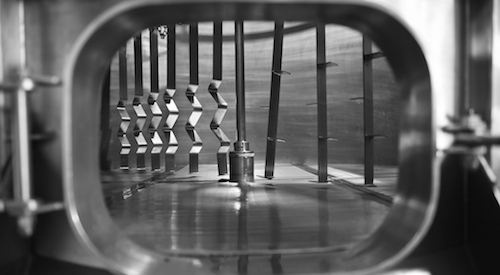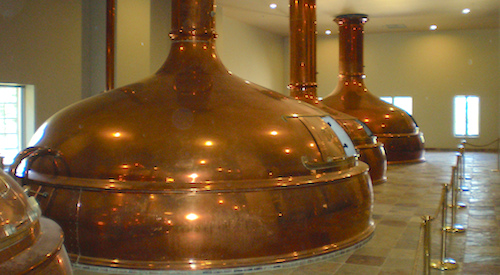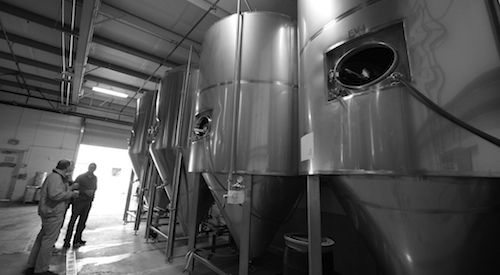There are basically three steps in the beer brewing process.
Mashing

Image via Matthew Peoples (CC License)
Mashing is where the starches of the malted grains turn into sugars. This part is called saccharification, and these sugars serve as ‘food’ for the yeast in the fermentation process. You start with boiling water in a mash tun, at temperatures around 120 to 160 degrees fahrenheit. A lower temperature creates less complex sugars, which are easier for the yeast to process, creating a thinner, dryer beer. At higher temperatures, more complex sugars are released, making it harder for the yeast to ferment, and creates a little more complex flavor, and residual sugars which add body, flavor, and texture to the beer. A single mashing process may involve pauses at different temperatures, to add layers of flavors along the way.
The Boil

Image via darius norvilas (CC License)
This is where the sweetened water, now called wort, is filtered off of the grains, and brought to a boil. This is important for several reasons: to remove any volatile off flavors or bacterias; to add caramelization of the sugars, which can add again to the richer, complex flavors of a beer. This is also the stage where flavors can begin to be introduced, usually with hops. At the end of the boil, solid particles are cleaned out in a whirlpool, and the wort is cooled to a certain temperature ready for the addition of yeast.
Fermentation

Image via CDReilly (CC License)
Fermentation is the addition of yeast to the wort. This is where the yeast begins to process all the sugars, the byproducts of which are alcohol and CO2. Fermentation vessels come in many styles and sizes, but most modern breweries now use cylindroconical vessels, or CCVs.
There are two main types of yeast* that may be added during the fermentation process: Ale Yeast (Saccharomyces cerevisiae), and Lager Yeast (Saccharomyces pastorianus). Ale yeast is fermented at a higher temperature, which allows it to become more active, and consume more sugars. In doing so, it raises the alcohol level, and can ferment at a faster rate. Lagers are fermented at a colder temperature, where the yeast is a little more ‘sluggish’, taking longer to ferment, but the result is a lighter, cleaner, crisper beer. The type of yeast and the length of fermentation is therefore slightly different depending on the type of beer being brewed.
*Brettanomyces is a genus of yeast important in brewing lambic, a beer produced not by the deliberate addition of brewer’s yeasts, but by spontaneous fermentation with wild yeasts and bacteria
From here, there may be other processes added to create certain beers, such as barrel-aging, or second fermentation in casks and bottles. But for a Beer 101 overview, the above three stages are the most important to understand in the beer brewing process, and ones that apply to all beers, whatever style they are and wherever they may be brewed.
Cheers!
by Bottleneck Management.
The Beer 101 Series
1. What is Beer?
2. The Brewing Process
3. Types of Beer
4. Types of Beer Glasses
5. The Perfect Pour
